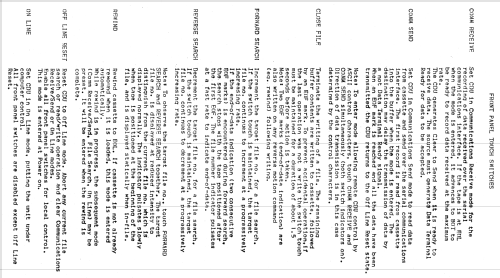Cassette data unit 7540
Borer Electronics AG; Biberist
- Pays
- Suisse
- Fabricant / Marque
- Borer Electronics AG; Biberist
- Année
- 1977
- Catégorie
- Processeur de signal et informatique
- Radiomuseum.org ID
- 305548
Cliquez sur la vignette du schéma pour le demander en tant que document gratuit.
- Gammes d'ondes
- - sans
- Particularités
- Magnétophone à cassettes
- Tension / type courant
- Alimentation Courant Alternatif (CA) / 220 Volt
- Haut-parleur
- HP dynamique à aimant permanent + bobine mobile
- Matière
- Boitier métallique
- De Radiomuseum.org
- Modèle: Cassette data unit 7540 - Borer Electronics AG; Biberist
- Forme
- Modèle de table profil bas (grand modèle).
- Dimensions (LHP)
- 484 x 222 x 498 mm / 19.1 x 8.7 x 19.6 inch
- Remarques
-
In the 1970s, when many minicomputers had only 16 bit addressing, and rarely more than 32 Kbytes of main memory, program and data files were typically stored and loaded by punched paper tape. The 7540 cassette data unit (CDU) is a microprocessor-controlled instrument that was designed in 1976 for recording digital computer programs and data on Philips cassettes, with the advantages of higher speed, lower cost, and a compact re-usable medium.
The CDU uses ANSI/ISO Complementary Return to Bias (CRB) 4-states dual-track recording, a method devised for reliable interchange operation in severe environments. In CRB recording, close matching of tape transport speeds is not required for reliable interchange, because wide variations in recording density can be accommodated. CRB recording also allows the use of reel-drive transports, which require less maintenance than conventional capstan/pinch roller cassette drives and can operate reliably at much higher speeds.
To allow the CDU to be used in a variety of application configurations it was provided with both serial and parallel interfaces. The serial interface conforms with EIA RS-232C (CCITT V24), and operates at send and receive rates that can be selected independently in the range 110-9600 Bauds by concentric switches on the rear panel. The parallel interface comprises two 8-bit bidirectional ports with encode and flag timing signals. The write port accepts data bytes to be written to cassette, and provides the CDU status output signals. The read port provides the data bytes read from the cassette and accepts the CDU control input signals. The serial and parallel interfaces can be connected simultaneously to different computers.
A LED display indicates the current file no., the target file no., beginning of file, in-file and end-of-data conditions. Individual LEDs indicate writing, reading, file protect, low tape, fault and cassette side. Front panel touch switches with integrated LEDs allow the selection of communications receive, communications send, forward and reverse search, rewind, close file, online and offline reset.
The 6800 microprocessor controller of the CDU provides several operating modes, three of which are for general use while the others are for special applications and maintenance. As a paper-tape emulator, the unit is used by the unmodified computer paper-tape software. Read/write control is automatic, but the CDU front panel switches must be used for all operations such as file search, close file and rewind. When the CDU is used as a system peripheral, all operations are controlled by special drivers in the computer, and the unit appears as a mini magnetic tape unit.
In serial communications mode data can be recorded transparently, or CDU control by ASCII control characters can be selected. Serial status messages are generated in response to remote interrogation in the latter case. The DB-25 RS-232C connector is wired as for a modem (DCE), and data terminal ready must be asserted to allow data transfer in either direction. Additional communications interface parameters, such as 7/8 bit data, even/odd parity and 1/2 stop bits can be selected by internal DIP switches.
The CDU was supplied in a bench-top case which could be converted for rack mounting in the field if required. An additional slave cassette drive can be connected to the CDU and powered from it. The buffered microprocessor system bus is also made available at the rear panel for accessing external equipment, so that the CDU can be used as a small autonomous data acquisition and recording system.
The CDU was designed by Bruce Taylor in 1976 and, following competitive bidding by 4 European companies, it was manufactured by Borer Electronics AG in 1977. The microelectronics revolution means that 40 years later a USB stick that costs no more than a digital cassette can hold thousands of times more data.
- Poids net
- 14.6 kg / 32 lb 2.5 oz (32.159 lb)
- Auteur
- Modèle crée par Bruce Taylor. Voir les propositions de modification pour les contributeurs supplémentaires.
- D'autres Modèles
-
Vous pourrez trouver sous ce lien 1 modèles d'appareils, 1 avec des images et 1 avec des schémas.
Tous les appareils de Borer Electronics AG; Biberist
Collections
Le modèle Cassette data unit fait partie des collections des membres suivants.










